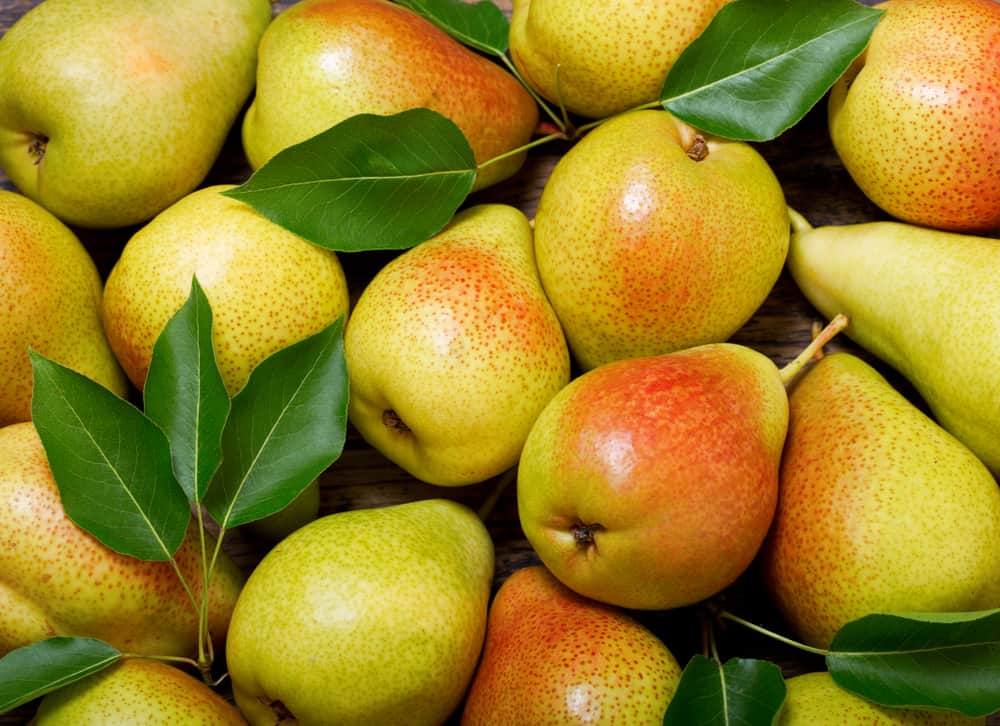Can Dogs Eat Pears? Read This First
@media (min-width: 481px) {
.mobile-top-content {
display: none;
}
}
#mobileTopContentCTACarouselControls { overflow: hidden; text-overflow: ellipsis; white-space: nowrap; }
.mobile-top-content .more { color: #fff; }
.mobile-top-content a { color: #fff; text-decoration: underline; }
.mobile-top-content a:hover { color: #fff; text-decoration: underline; }
@media (max-width: 480px) {
.mobile-top-content {
background-color: #06a10b;
color: #fff;
text-align: center;
/*height: 60px;
padding-top:5px;*/
font-size:80%;
/* display: block; */
margin: 0px -30px;
}
}
Fruits aren’t typically on a dog’s menu. They are carnivores after all, which means they prefer to eat meat. However, after spending thousands of years evolving alongside humans, it’s only natural that they are able to eat some of the things we eat. If you’re a dog owner that loves to eat pears, you’ve probably wondered at some point if it is safe to give pears to your dog. So can dogs eat pears? Surprisingly, the answer to this question is yes.
Although pears are not toxic to dogs, and it’s okay to give them some if you want, there are still some things you need to know about giving your dog this fruit. Read on to discover how to safely give your dog pear, and potential risks to avoid.
How Much Pear Can Dogs Eat?

Nitr/Shutterstock.com
button.pulse {
transform: scale(1); animation: pulse 2s infinite;
box-shadow: 0 0 0 0 rgba(11, 247, 25, 1);
}
@keyframes pulse {
0% { transform: scale(0.90); box-shadow: 0 0 0 0 rgba(11, 247, 25, 0.5); }
60% { transform: scale(1); box-shadow: 0 0 0 15px rgba(11, 247, 25, 0); }
100% { transform: scale(0.90); box-shadow: 0 0 0 0 rgba(11, 247, 25, 0); }
}
Although it is safe for dogs to eat pears, that doesn’t mean you can let your dog eat all the pears they want on a regular basis. This fruit can be a healthy snack rich in vitamins and fiber. However, just like any food you feed your dog, moderation is important. Consuming an excess amount of pear can lead to stomach upset.
While there are no specific figures for the maximum amount of pears that dogs can eat, veterinarians typically recommend that treats should take up not more than 10% of a dog’s daily food intake. This means for a small dog, a small slice of pear every now and then would be just great. If you’re uncertain about how much pears to give your dog, you can ask your vet for specific recommendations.
The Health Benefits of Feeding Pears
A slice of fresh pear taken in moderate quantity is a delicious and healthy treat for dogs. Like most fruits, pears are a good source of vitamin C. However, this nutrient is not really as essential for dogs as it is for humans. Still, there are other nutrients it contains that can be beneficial in various ways. This includes:
- Minerals: Pears contain minerals like potassium, copper, zeaxanthin, and anthocyanins lutein, all of which contribute to general body wellness and improve eye health.
- Sugar: Sugar is naturally present in all fruits and this applies to pears as well. The good thing about the sugar in pears is that it is released slowly into the bloodstream. This makes it acceptable for dogs that are diabetic because it does not cause a huge spike in blood sugar as other treats may.
- Fiber: Pears contain a healthy supply of good fiber which is beneficial for your dog’s gut health. Fiber helps to feed the good bacteria that aid digestion in the gastrointestinal tract. Fiber also helps to bulk the dog’s poo, making it easier for your dog to pass and for you to scoop up.
What Are The Risks Of Feeding Pears To Your Dog?

Maya Shustov/Shutterstock.com
We have established that pears are healthy snacks for dogs. However, they may not always be safe to feed to your canine companion. Not all pears can be fed to dogs and not all dogs can have them. The following are some of the risks you should consider before giving your dog this fruit as a treat.
Cores and Seeds
Before giving your dog pears, make sure you remove the core and seed. The seeds of pears contain a chemical compound known as amygdalin. This chemical is present in the seed of other plants like apple seeds as well. When it’s ingested, it releases the poisonous compound cyanide into the body. Although pear seed only contains trace amounts of cyanide, it’s best to avoid consuming at all. A dog would have to chew a lot of seeds to be affected by this toxin. However, in the unlikely chance that cyanide poisoning occurs, it can be life-threatening. This is why it is best to avoid it entirely
Canned Pears Are Not Recommended
Feeding canned pears to your dog is not a healthy choice. They tend to contain a much higher amount of sugar compared to raw fruits which makes them unhealthy. Canned pears are usually soaked in syrup or juice that contains an unhealthy amount of added sugar. A diet high in sugar can increase the risk of dental issues, diabetes, obesity, and related health issues.
Spices Or Seasoning
The best way to feed your dog this food is to serve it cooked without seasoning or spices. The rich flavor from spices can hurt your dog’s stomach. To cook, simply boil the pear in water and serve plain without any additives.
Homegrown Pears Aren’t Always Safe
One might think homegrown pears are better for dogs. This is mostly true. However, even if you have a pear tree in your garden, you should not allow your dog to eat pears directly from the tree or on the ground. First, your dog will be eating the fruit directly without washing or cooking and this isn’t recommended. Also, there’s the risk of choking if the dog doesn’t chew it properly. Then there’s the possibility of eating the core and the seeds which exposes your pup to cyanide.
Dogs With Tummy Issues
If your dog suffers from any type of stomach trouble, it’s best not to feed pears or any type of food that isn’t recommended by a veterinarian. The fact that pears are rich in sugar means that they aren’t a great snack choice for dogs with tummy issues.
Obesity
If your dog is overweight, it should be on a strictly controlled diet. You should be familar with the list of foods that are safe for dogs. Although a special obesity diet may still contain fruits and vegetables, they must all be approved by a vet.
Diabetes
Dogs with diabetes may be able to eat pear safely as an occasional treat. Even though the sugar content is on the high side, it is released slowly. However, it is better to simply avoid foods that contain high sugar like this because it is riskier for your dog.
How To Safely Feed Pears To Dogs

alexei_tm/Shutterstock.com
To feed pears to your dogs, make sure the fruit is ripe and fresh. Wash the fruit, then cut it into small bite-sized pieces. Be sure to remove the stalk and seed as they may contain harmful chemicals that are unsafe for dogs.
Moderation is important when giving pears to your dog. It should only be given as an occasional treat and not a full meal. Asides from serving slices of the fruit, some of the other ways you can give your dog pears include:
- Blend the pear into a smoothie along with some yogurt and a pinch of cinnamon. You can also pour some of the smoothies into an ice cube to make popsicles.
- Grate the pear and mix it in with your dog’s regular food
- Freeze some slices of pear along with other fruits such as mango, raspberries, cantaloupe, and so on. Ensure that all the fruits are safe for dogs.
- Add pear as a sweetener to baked homemade treats for your dog.
Conclusion
Before giving your dog a new treat, it is always better to speak to your veterinarian. Pears are safe for dogs to eat, but they might not be safe for your dog due to specific conditions. Only a vet would be able to evaluate your dog’s health status and recommend the best quantity and the right way to add pears to their diet.
Ready to discover the top 10 cutest dog breeds in the entire world?
How about the fastest dogs, the largest dogs and those that are — quite frankly — just the kindest dogs on the planet? Each day, AZ Animals sends out lists just like this to our thousands of email subscribers. And the best part? It’s FREE. Join today by entering your email below.
More from A-Z Animals
.more-snake-card-image { max-height:140px !important; }
@media (min-width: 481px) {
.mobile-top-content {
display: none;
}
}
#mobileTopContentCTACarouselControls { overflow: hidden; text-overflow: ellipsis; white-space: nowrap; }
.mobile-top-content .more { color: #fff; }
.mobile-top-content a { color: #fff; text-decoration: underline; }
.mobile-top-content a:hover { color: #fff; text-decoration: underline; }
@media (max-width: 480px) {
.mobile-top-content {
background-color: #06a10b;
color: #fff;
text-align: center;
/*height: 60px;
padding-top:5px;*/
font-size:80%;
/* display: block; */
margin: 0px -30px;
}
}
Fruits aren’t typically on a dog’s menu. They are carnivores after all, which means they prefer to eat meat. However, after spending thousands of years evolving alongside humans, it’s only natural that they are able to eat some of the things we eat. If you’re a dog owner that loves to eat pears, you’ve probably wondered at some point if it is safe to give pears to your dog. So can dogs eat pears? Surprisingly, the answer to this question is yes.
Although pears are not toxic to dogs, and it’s okay to give them some if you want, there are still some things you need to know about giving your dog this fruit. Read on to discover how to safely give your dog pear, and potential risks to avoid.
How Much Pear Can Dogs Eat?

Nitr/Shutterstock.com
button.pulse {
transform: scale(1); animation: pulse 2s infinite;
box-shadow: 0 0 0 0 rgba(11, 247, 25, 1);
}
@keyframes pulse {
0% { transform: scale(0.90); box-shadow: 0 0 0 0 rgba(11, 247, 25, 0.5); }
60% { transform: scale(1); box-shadow: 0 0 0 15px rgba(11, 247, 25, 0); }
100% { transform: scale(0.90); box-shadow: 0 0 0 0 rgba(11, 247, 25, 0); }
}
Although it is safe for dogs to eat pears, that doesn’t mean you can let your dog eat all the pears they want on a regular basis. This fruit can be a healthy snack rich in vitamins and fiber. However, just like any food you feed your dog, moderation is important. Consuming an excess amount of pear can lead to stomach upset.
While there are no specific figures for the maximum amount of pears that dogs can eat, veterinarians typically recommend that treats should take up not more than 10% of a dog’s daily food intake. This means for a small dog, a small slice of pear every now and then would be just great. If you’re uncertain about how much pears to give your dog, you can ask your vet for specific recommendations.
The Health Benefits of Feeding Pears
A slice of fresh pear taken in moderate quantity is a delicious and healthy treat for dogs. Like most fruits, pears are a good source of vitamin C. However, this nutrient is not really as essential for dogs as it is for humans. Still, there are other nutrients it contains that can be beneficial in various ways. This includes:
- Minerals: Pears contain minerals like potassium, copper, zeaxanthin, and anthocyanins lutein, all of which contribute to general body wellness and improve eye health.
- Sugar: Sugar is naturally present in all fruits and this applies to pears as well. The good thing about the sugar in pears is that it is released slowly into the bloodstream. This makes it acceptable for dogs that are diabetic because it does not cause a huge spike in blood sugar as other treats may.
- Fiber: Pears contain a healthy supply of good fiber which is beneficial for your dog’s gut health. Fiber helps to feed the good bacteria that aid digestion in the gastrointestinal tract. Fiber also helps to bulk the dog’s poo, making it easier for your dog to pass and for you to scoop up.
What Are The Risks Of Feeding Pears To Your Dog?

Maya Shustov/Shutterstock.com
We have established that pears are healthy snacks for dogs. However, they may not always be safe to feed to your canine companion. Not all pears can be fed to dogs and not all dogs can have them. The following are some of the risks you should consider before giving your dog this fruit as a treat.
Cores and Seeds
Before giving your dog pears, make sure you remove the core and seed. The seeds of pears contain a chemical compound known as amygdalin. This chemical is present in the seed of other plants like apple seeds as well. When it’s ingested, it releases the poisonous compound cyanide into the body. Although pear seed only contains trace amounts of cyanide, it’s best to avoid consuming at all. A dog would have to chew a lot of seeds to be affected by this toxin. However, in the unlikely chance that cyanide poisoning occurs, it can be life-threatening. This is why it is best to avoid it entirely
Canned Pears Are Not Recommended
Feeding canned pears to your dog is not a healthy choice. They tend to contain a much higher amount of sugar compared to raw fruits which makes them unhealthy. Canned pears are usually soaked in syrup or juice that contains an unhealthy amount of added sugar. A diet high in sugar can increase the risk of dental issues, diabetes, obesity, and related health issues.
Spices Or Seasoning
The best way to feed your dog this food is to serve it cooked without seasoning or spices. The rich flavor from spices can hurt your dog’s stomach. To cook, simply boil the pear in water and serve plain without any additives.
Homegrown Pears Aren’t Always Safe
One might think homegrown pears are better for dogs. This is mostly true. However, even if you have a pear tree in your garden, you should not allow your dog to eat pears directly from the tree or on the ground. First, your dog will be eating the fruit directly without washing or cooking and this isn’t recommended. Also, there’s the risk of choking if the dog doesn’t chew it properly. Then there’s the possibility of eating the core and the seeds which exposes your pup to cyanide.
Dogs With Tummy Issues
If your dog suffers from any type of stomach trouble, it’s best not to feed pears or any type of food that isn’t recommended by a veterinarian. The fact that pears are rich in sugar means that they aren’t a great snack choice for dogs with tummy issues.
Obesity
If your dog is overweight, it should be on a strictly controlled diet. You should be familar with the list of foods that are safe for dogs. Although a special obesity diet may still contain fruits and vegetables, they must all be approved by a vet.
Diabetes
Dogs with diabetes may be able to eat pear safely as an occasional treat. Even though the sugar content is on the high side, it is released slowly. However, it is better to simply avoid foods that contain high sugar like this because it is riskier for your dog.
How To Safely Feed Pears To Dogs

alexei_tm/Shutterstock.com
To feed pears to your dogs, make sure the fruit is ripe and fresh. Wash the fruit, then cut it into small bite-sized pieces. Be sure to remove the stalk and seed as they may contain harmful chemicals that are unsafe for dogs.
Moderation is important when giving pears to your dog. It should only be given as an occasional treat and not a full meal. Asides from serving slices of the fruit, some of the other ways you can give your dog pears include:
- Blend the pear into a smoothie along with some yogurt and a pinch of cinnamon. You can also pour some of the smoothies into an ice cube to make popsicles.
- Grate the pear and mix it in with your dog’s regular food
- Freeze some slices of pear along with other fruits such as mango, raspberries, cantaloupe, and so on. Ensure that all the fruits are safe for dogs.
- Add pear as a sweetener to baked homemade treats for your dog.
Conclusion
Before giving your dog a new treat, it is always better to speak to your veterinarian. Pears are safe for dogs to eat, but they might not be safe for your dog due to specific conditions. Only a vet would be able to evaluate your dog’s health status and recommend the best quantity and the right way to add pears to their diet.
Ready to discover the top 10 cutest dog breeds in the entire world?
How about the fastest dogs, the largest dogs and those that are — quite frankly — just the kindest dogs on the planet? Each day, AZ Animals sends out lists just like this to our thousands of email subscribers. And the best part? It’s FREE. Join today by entering your email below.














